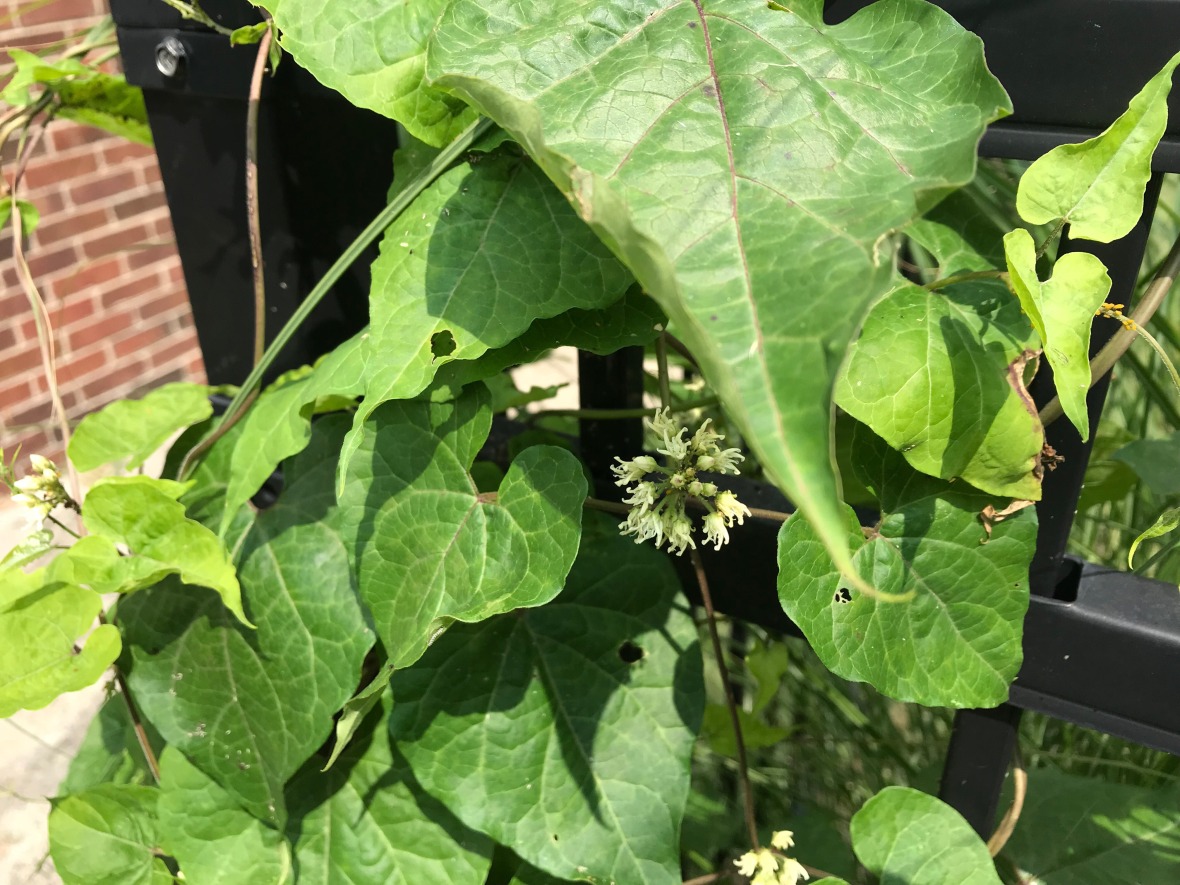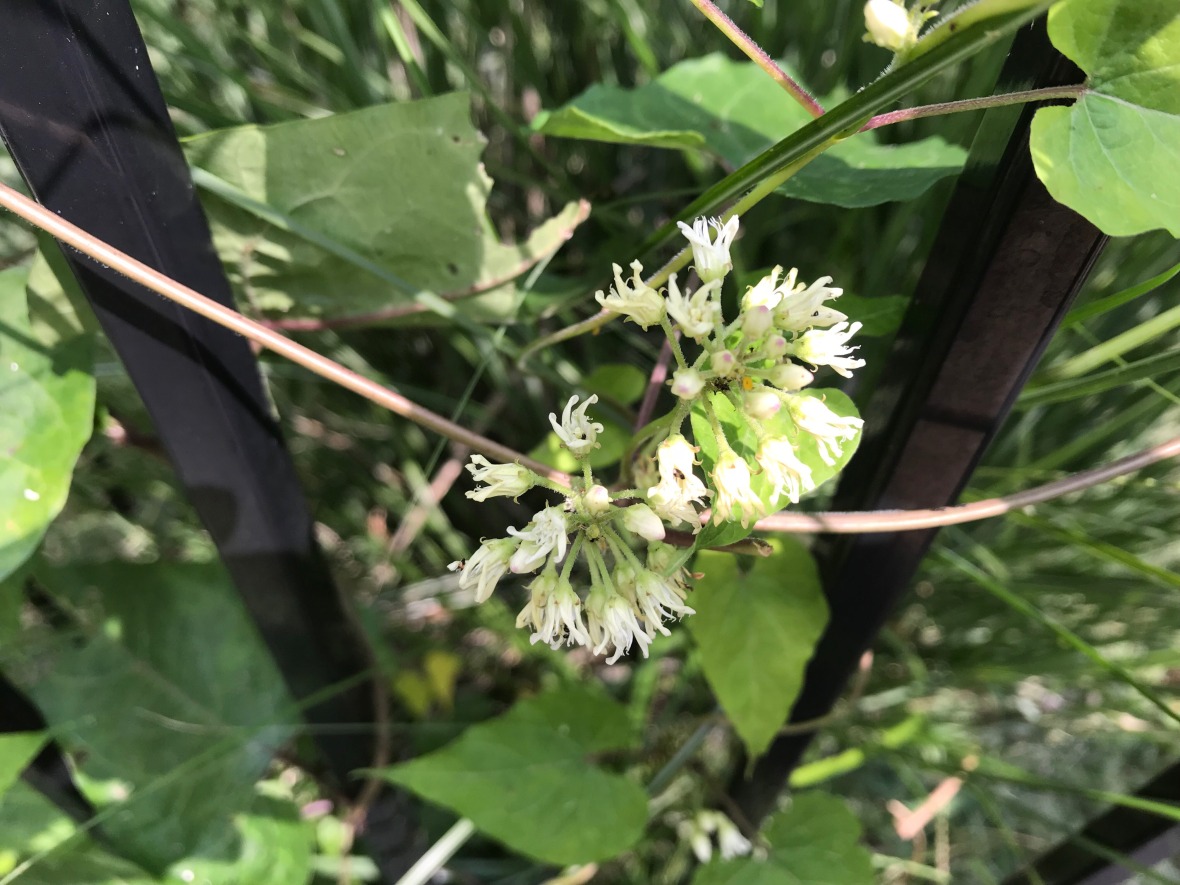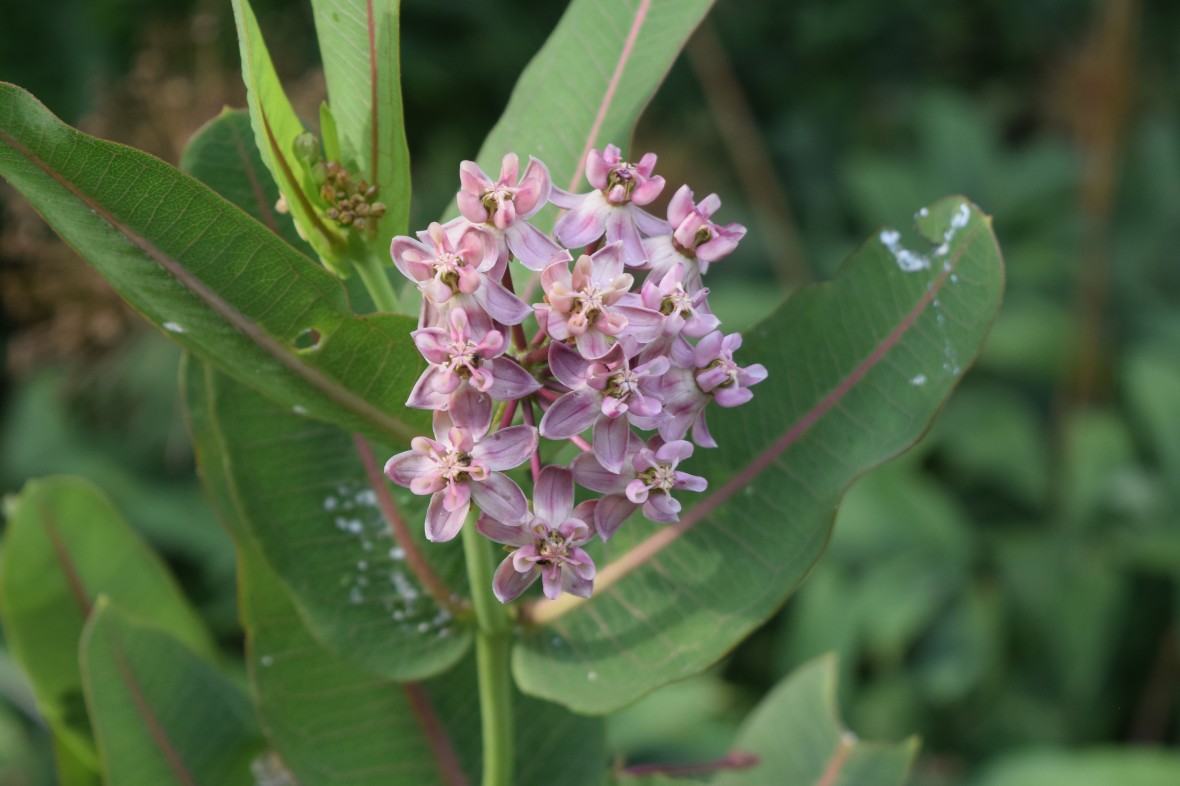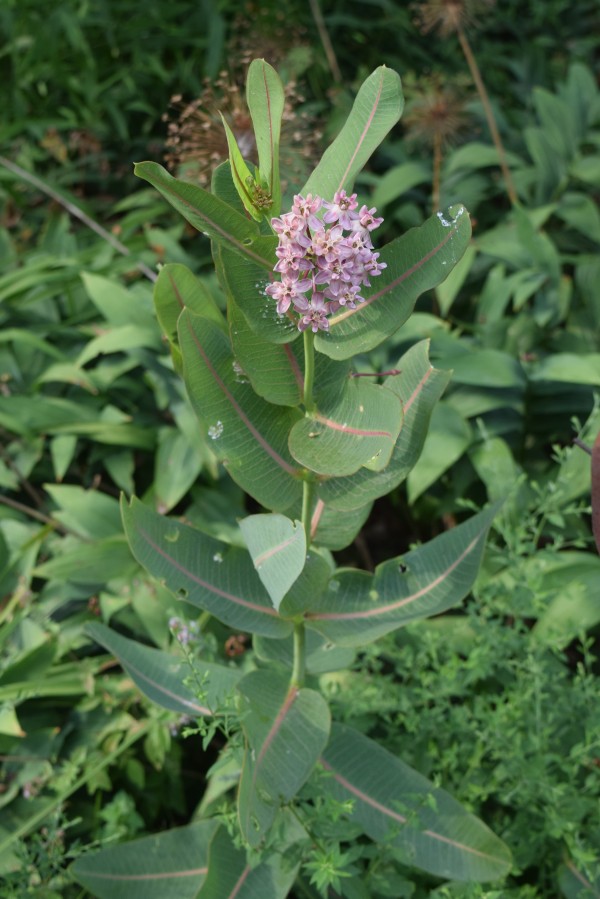Milkweed Surprise
So my friend and coworker Joanna was telling me about how excited she was to be finding Monarch butterfly eggs on what she called a “milkweed vine” in her backyard. That’s great, I told her authoritatively, but if it’s a milkweed it can’t be a vine.

I was going to Springfield (where Joanna lives) at the end of the week for a conference, so we agreed that I would come to her house after we were done with our work obligations. She even said she would give me some Monarch eggs to take home, because she was finding more than she could handle. This made me happy and jealous at the same time.
When I got to her house, I found a vining plant that looked a bit like Bindweed. It did indeed have what appeared to be numerous leaves with Monarch eggs, and at least one tiny caterpillar. Clearly it was time to consult the internet! We headed for the first floor study in Joanna’s house.
Turns out there is a vining Milkweed native to much of eastern North America. It’s known by such common names Honeyvine or Bluevine, but it’s botanical name is Cynanchum laeve. So it is not of the genus Asclepias but it is in the Milkweed subfamily of plants, who have the unfortunate name Asclepiadoideae.

Some of the articles that popped up on Honeyvine indicated that it was an invasive pest, an aggressive self-sower with a taproot impervious to all the powers of mankind. This must be one reason why Honeyvine is not one of the Milkweeds that you will find for sale at plant nurseries or garden centers. Another is that it is not particularly ornamental.
Lining one bookshelf in Joanna’s study was a series of small tupperware containers wrapped in women’s stockings. Each contained a Honeyvine leaf with a Monarch egg or caterpillar. Each egg/caterpillar has been given a name by Joanna’s two young daughters. I wish I had thought of taking a picture, but I didn’t.
Anyway, Joanna gave me 8 Honeyvine leaves with Monarch eggs, plus one caterpillar, for me to take home. They will have to get used to Butterflyweed (Asclepias tuberosa) and Rose Milkweed (A. incarnata) leaves at my house.

On another Milkweed front, I finally got some blooms out of my Prairie Milkweed (Asclepias sullivantii). Prairie Milkweed is very similar to Common Milkweed (A. syriaca) but allegedly much less aggressive. This may be true as Prairie Milkweed did not readily establish itself in our garden.

Now that this one plant is doing well, I’m looking forward to a nice clump developing. It’s an attractive plant, I think.
Have you ever heard of Honeyvine? Have you had any Milkweed surprises lately?





I’ve not heard of honeyvine, but we do have another milkweed vine here in Texas: pearl milkweed,or green milkweed vine (Matelea reticulata). The flowers are gorgeous — I want a pair of earrings made just like them. It’s also in the Asclepiadaceae, despite being a different genus. Here’s a bit of information on it..
I’ll be darned. The honeyvine’s shown as native in parts of Texas both on the USDA and BONAP sites — and one of the counties where it’s shown is my very own. I guess I’d better get familiar with it!
I have never heard of honeyvine; but that is no surprise. There are many species in the East that I have never heard of. There was actually a milkweed surprise though. I had never grown it before, and really had no desire to do so, but one of my colleagues procured one for a new landscape where it had been doing quite well. That was about the time that I noticed everyone else talking about it online. I thought that the seed capsules looked funny, but did not see any on the specimen at work. Well, I had not seen it in a while. When I saw it on Friday, it too had those funny looking bean pods on them, and a few has split open to disperse those fly away seeds. I sort of want to take some of the seeds and throw them out in sunny but moist unlandscaped areas.
Not a bad idea. I suppose in California the Tropical Milkweed (A. currasavica) is commonly grown?
Weirdly, none of the milkweeds are common. They are available, and popular among a certain crowd, but just not too common. I am not familiar with the tropical milkweed.
I just planted some Prairie Milkweed. How long did it take to establish in your garden? And was it bothered at all by rabbits? I ordered five but one was eaten by some sort of critter when they were left outside at ground level. Thanks!
Not bothered by rabbits, but rather slow to establish – 2-3 years.
Wow that’s very interesting! It’s always a thrill to find out about new plants! I’ve never seen or heard of it before. Hope your monarch eggs do well… I spotted a monarch butterfly in the field yesterday and thought about your garden right away!
It may be more common to the south of you.
I had a not good surprise when we discovered our one butterfly weed was covered with those awful orange aphids. Knocked a lot of them off with the hose. But there are still hordes of them. A little good news came today when we found at least one ladybug on there, too. Hopefully my live-&-let-live policies will not result in a dead plant. There were lots of monarch caterpillars on it this year, so we were hopeful that something good was getting started.
I think it’s very rare that the aphids do enough damage to kill the plant. Glad to hear you had caterpillars.
I absolutely hate that vine. Don’t throw away those leaves in your compost or garden in any way. Don’t even think about that vine or it will pop up in your garden and you will be fighting it the rest of your gardening life. It is sneaky and deadly. It crawls up the inside of a shrub and you find that the top of the shrub has been shaded out and it wilts before you can get it ripped out. UGH… A bad ombre. I have had Monarchs lay eggs on it before. I was shocked to find that a Monarch larva once crawled up onto a tomato and proceeded to turn into a chrysalis. It almost made it to opening as a butterfly but was parasitised by some wasp. It made me sad. The monarch eggs on the vine is not enough to let it grow in your garden. BEWARE.
I consider myself very well warned!
I have also just recently learned of “Honeyvine” which has been the bane of my garden. I had confused it with bindweed even though the flowers are very different. The Monarchs use it as a host plant but don’t let it grow and certainly don’t let it go to seed! I agree, you will fight it the rest of your life. Once we’re gone it will live on.
Fortunately no sign of it in my garden. Another plant pest to watch out for!
Well, I’ve heard of it now and sure enough, it’s in the LBJWC database! I don’t recall ever seeing it before. However, I’ll echo Shoreacres: I want some earring like the blooms of pearl milkweed!
I found it in that database, too, but they didn’t seem to have much to say about it. With luck you never will see it.
Phew! Talk about the good, the bad, and the ugly. At first I was excited about honey vine. After reading the other comments, not so much. But how great to have more little monarchs to foster.
Yes, that would be the silver lining.
That is a fun surprise! You will have to keep up updated on your eggs!
I will, unless of course they come to a bad end.
How cool to learn about a new plant! I’ve never seen a monarch in our region and found out that, because the host plants don’t occur naturally here, neither do the monarchs. Good luck with your eggs and caterpillar!
There is a west coast Monarch migration in California, but I suppose it doesn’t reach into Oregon.
Oh my, yes, I’ve learned about this bad boy!!! Found what seemed to be a milkweed seedling, but it was vining. Hmmmm. Researched it, found out about it’s bad rep, and dug half way to China to remove it. I’m almost hesitant to say I haven’t seen any in my garden since.
I have a pot of annual gomphocarpus physocarpus (Dino egg milkweed, the seedpods are so cool) on the patio that has just been covered in monarch caterpillars, 7 of which I’m raising. The rest’ll just have to make it on their own. Fun stuff!
That’s another member of the Milkweed family I have never heard of!
I do hope you’ll show us the progress of the eggs and caterpillar.
I intend to, unless they come to a tragic end.
I’ve never heard of that plant and with your description, do not want to find it in my garden. How fun to have some monarchs to watch grow. We will see a lot in fall when they pass through Texas to Mexico.
Yes, the fall migration seems to have started.
I haven’t ever heard of it or seen it. I am seeing quite a few monarchs now though.
That’s good news – on both counts! I think the vine likes warmer climates than yours.
They’re welcome to them. If it was any warmer I’d move!
Yes, I had heard of Honeyvine, but it always surprises me that monarchs can use it as a host plant since it’s a different genus. Your Prairie Milkweed is lovely. All my milkweeds are getting pummeled with many inches of rain tonight. I hope the caterpillars (and any chrysalides and butterflies outside) will be OK.
Fortunately you’ve got many of them snug inside. Apparently there is more than one genus in the Milkweed family, something I had not realized until now.
Always great to read good news from Springfield! Thanks.
> WordPress.com
It doesn’t come that often.
Hi Jason .. that vine is new to me .. I have never heard of it before .. I do have one heck of a problem with an old Dutchman’s Pipe vine I thought I got rid of in the front garden only to find it WILL NOT LEAVE no matter what I have done to it .. it doesn’t have the added benefit of butterfly eggs on it either .. any advice on how to get rid of it without harming any of my other plants would be appreciated !
I have the run of the mill orange milkweed and they don’t seem to have much action going on either. The one plant was the dill .. and that has finished .. I so wish I had taken the cats and “boarded” them in containers to make sure they made it through alright. Lesson learned on that experience.
Nice to know you adopted wonderful potentials !! Good for you : )
For me it’s not dill but parsley and fennel where I see the black swallowtail caterpillars. Dutchman’s Pipe is a host plant for another swallowtail, called pipevine swallowtail. I have the vine but have never seen the cats.
Looking forward to hearing more about those eggs!xxx
I’ll let you know.
Fascinating to learn of this vine, which according to the Flora of Virginia is found in the piedmont, but not our mountain county. I’m sure it would grow here, but not interested in trying it after the first-hand reports. And also because the common milkweed here finally seems to be having an impact.
For the last several weeks there’ve been quite a few monarchs in the garden, getting the last of the Joe Pye nectar and fluttering around the milkweed. Asters, ironweed, and wingstem are available in volume for feeding, too, so I hope this will become a productive and reproductive stop for them.
I hope so too! Not familiar with wingstem.
I had heard of a vining milkweed. It seems like all vines are invasive! 😦 Your Sullivan’s milkweed looks nice. Did it set seed?
I don’t think so, but I want to go back and recheck.